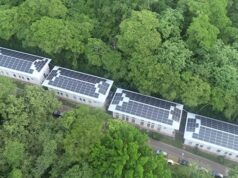
Green building owners are always looking for more efficient and cost-effective heating solutions in order to meet sustainability goals and reduce operating expenses. Innovations in commercial heating technology are providing more efficient heating options to consider than ever before. One example is the adaptation of condensing furnace technology, which was previously only used in residential furnace and indoor applications, to commercial rooftop units.
How it Works
In an indirect fired gas furnace, natural gas (or LP) is burned, creating very hot flue gases that travel through a heat exchanger. The heat exchanger heats up and in turn transfers this heat to the ventilation air passing thru the HVAC unit. (At no time do the flue gases mix with the ventilation air being introduced to the space to keep the ventilation air free of any of the byproducts of combustion). The process of passing thru the heat exchanger cools the flue gases, but they are still relatively hot when they exit thru a vent, often around 400°F or even higher.
In an indirect fired condensing furnace, more heat is transferred from the flue gases to the heat exchanger and in turn to the supply air passing thru the HVAC unit. This allows the furnace to burn less fuel than a standard unit while still heating the supply air to the same target temperature. The additional heat transfer is made possible using a secondary heat exchanger in the furnace and increases the overall distance the flue gases must travel before being exhausted from the furnace completely. So much more heat is transferred to the supply air that the flue gases on an indirect fired condensing furnace are significantly cooler when they are exhausted from a HVAC unit, generally under 150°F. The further cooling of flue gases in an indirect fired condensing furnace results in increased thermal efficiency of the HVAC unit but does, however, lead to the formation of condensate inside the secondary heat exchanger.
Secondary heat exchangers specially engineered with strategies for condensate removal are made out of a robust material (AL294C stainless steel or similar). The condensate is slightly acidic and must be neutralized prior to disposal. Again, a traditional, non-condensing, indirect-fired furnace is not engineered to deal with the formation of condensate inside its heat exchangers in large volumes.
Advantages of Condensing Furnace Tech
The clear advantage of a condensing indirect-fired furnace is the increased thermal efficiency, which translates into reduced annual operational costs. Whereas most non-condensing indirect furnaces have a thermal efficiency around 80 percent to 83 percent, condensing indirect fired furnaces are in the range of 90 percent to 93 percent efficient. For hotels and other properties that require high volumes of ventilation air introduced into the building, an indirect-fired condensing furnace can help save thousands over the lifetime of the HVAC unit while reducing CO2 emissions.
As an example, a hotel in Chicago may require 5,000 CFM of outside air, introduced at 72°F, 24 hours a day, 7 days a week, to satisfy ventilation code requirements. In the winter, this can mean substantial energy costs to bring the outside air up to the target temperature.
If the HVAC equipment on this property utilized condensing indirect-fired furnaces (90 to 94 percent efficient) instead of standard indirect-fired furnaces (80 to 83 percent efficient), operational costs could be reduced by more than $1,500 per year and CO2 emissions by over 13,000 lbs/year.
The actual savings depend on a number of factors including changing fuel prices, change in building use or construction. Before deciding on using condensing furnace technology, a building owner should discuss potential operational savings with their consulting engineer.
Looking to the Future
Innovative heating technologies are giving green building owners the tools needed to better reach sustainability goals. With its ability to reduce operating expenses and emissions, the integration of condensing furnace tech in commercial rooftop HVAC units is an important part of this toolkit.
Joseph Ellison is Sales Manager, Engineered Products, for Modine.







